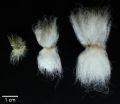(Press-News.org) CORVALLIS, Ore. - Researchers at Oregon State University have invented a new technology that can increase the bandwidth of WiFi systems by 10 times, using LED lights to transmit information.
The technology could be integrated with existing WiFi systems to reduce bandwidth problems in crowded locations, such as airport terminals or coffee shops, and in homes where several people have multiple WiFi devices.
Experts say that recent advances in LED technology have made it possible to modulate the LED light more rapidly, opening the possibility of using light for wireless transmission in a "free space" optical communication system.
"In addition to improving the experience for users, the two big advantages of this system are that it uses inexpensive components, and it integrates with existing WiFi systems," said Thinh Nguyen, an OSU associate professor of electrical and computer engineering. Nguyen worked with Alan Wang, an assistant professor of electrical and computer engineering, to build the first prototype.
The prototype, called WiFO, uses LEDs that are beyond the visual spectrum for humans and creates an invisible cone of light about one meter square in which the data can be received. To address the issue of a small area of usability, the researchers created a hybrid system that can switch between several LED transmitters installed on a ceiling, and the existing WiFi system.
"I believe the WiFO system could be easily transformed into a marketable product, and we are currently looking for a company that is interested in further developing and licensing the technology," Nguyen said.
The system can potentially send data at up to 100 megabits per second. Although some current WiFi systems have similar bandwidth, it has to be divided by the number of devices, so each user might be receiving just 5 to 10 megabits per second, whereas the hybrid system could deliver 50-100 megabits to each user.
In a home where telephones, tablets, computers, gaming systems, and televisions may all be connected to the internet, increased bandwidth would eliminate problems like video streaming that stalls and buffers.
The receivers are small photodiodes that cost less than a dollar each and could be connected through a USB port for current systems, or incorporated into the next generation of laptops, tablets, and smartphones.
A provisional patent has been secured on the technology, and a paper was published in the 17th ACM International Conference on Modeling, Analysis and Simulation of Wireless and Mobile Systems. The research has been supported by the National Science Foundation.
INFORMATION:
NEW YORK (April 20, 2015) -- Genomic studies have illuminated the ways in which malfunctioning genes can drive cancer growth while stunting the therapeutic effects of chemotherapy and other treatments. But new findings from Weill Cornell Medical College investigators indicate that these genes are only partly to blame for why treatment that was at one point effective ultimately fails for about 40 percent of patients diagnosed with the most common form of non-Hodgkin Lymphoma.
The study, published April 20 in Nature Communications, suggests that global changes in cancer ...
A rigorous analysis of antimalarial drug quality conducted in Cambodia and Tanzania found no evidence of fake medicines, according to new research published in the American Journal of Tropical Medicine and Hygiene.
But researchers warn that routine surveillance is crucial as poor quality medicines exist, leaving malaria patients at risk of dying and increasing the risk of drug resistance.
Previous reports had suggested that up to one third of antimalarials could be fake. Researchers from the Artemisinin-based Combination Therapy (ACT) Consortium at the London School ...
Dispensing of prescription opioid pain relievers and prescription opioid overdoses both dropped substantially after abuse-deterrent extended-release oxycodone hydrochloride was introduced on the pharmaceutical market and the narcotic drug propoxyphene was withdrawn from the U.S. market in 2010, according to an article published online by JAMA Internal Medicine.
The abuse-deterrent OxyContin formulation is resistant to crushing and dissolving, actions that have been used to bypass the extended-release mechanism to get a quicker and more intense high. Propoxyphene (also ...
Children whose families and pediatricians were most faithful to an obesity intervention program that included computerized clinical decision support for physicians and health coaching for families experienced the greatest improvements in body mass index (BMI), according to an article published online by JAMA Pediatrics.
The prevalence of childhood obesity in the United States remains at historically high levels. Clinical approaches that are cost-effective and scalable for obesity reduction in children are a public health priority. However, interventions to improve BMI ...
(Boston) - Results of a new study led by Boston Medical Center (BMC) researchers, in collaboration with Harvard Medical School (HMS), indicate that the introduction of abuse-deterrent OxyContin, coupled with the removal of propoxyphene from the US prescription marketplace, may have played a role in decreasing opioid prescribing and overdoses. The findings, published in JAMA Internal Medicine, showed that these two changes led to a 19 percent drop in prescription opioid supply that was mirrored by a 20 percent drop in prescription opioid overdose between August 2010 and ...
Poor quality medicines are a real and urgent threat that could undermine decades of successful efforts to combat HIV/AIDS, malaria and tuberculosis, according to the editors of a collection of journal articles published today. Scientists report up to 41 percent of specimens failed to meet quality standards in global studies of about 17,000 drug samples. Among the collection is an article describing the discovery of falsified and substandard malaria drugs that caused an estimated 122,350 deaths in African children in 2013. Other studies identified poor quality antibiotics, ...
Researchers from the University of Birmingham have identified an important new way in which our immune systems are regulated, and hope that understanding it will help tackle the debilitating effects of type 1 diabetes, rheumatoid arthritis and other serious diseases.
The team discovered a novel pathway that regulates the movement of pathogenic immune cells from the blood into tissue during an inflammatory response.
A healthy, efficient immune system ordinarily works to damp down inflammation and carefully regulate the magnitude of the response to infection and disease. ...
A University of Texas at Austin scientist, working with an international research team, has developed the most precise sequence map yet of U.S. cotton and will soon create an even more detailed map for navigating the complex cotton genome. The finding may help lead to an inexpensive version of American cotton that rivals the quality of luxurious Egyptian cotton and helps develop crops that use less water and fewer pesticides for a cotton that is easier on the skin and easier on the land.
Z. Jeffrey Chen and his collaborators, Tianzhen Zhang and Wangzhen Guo at Nanjing ...
Using the latest genome sequencing techniques, a research team led by scientists from UC San Francisco (UCSF), Baylor College of Medicine, and Texas Children's Hospital has identified a new autoimmune syndrome characterized by a combination of severe lung disease and arthritis that currently has no therapy.
The hereditary disorder, which appears in early childhood, had never been diagnosed as a single syndrome. The new research revealed that it is caused by mutations in a single gene that disrupt how proteins are shuttled around within cells. Patients with the newly ...
We often make quick strategic decisions to attack an opponent or defend our position, yet how we make them is not well understood. Now, researchers at the RIKEN Brain Science Institute in Japan have pinpointed specific brain regions related to this process by examining neural activity in people playing shogi, a Japanese form of chess. Published in Nature Neuroscience, the study shows that two different regions within the cingulate cortex--one toward the front of the brain and the other toward the back--separately encode the values of defensive and offensive strategies.
Like ...


